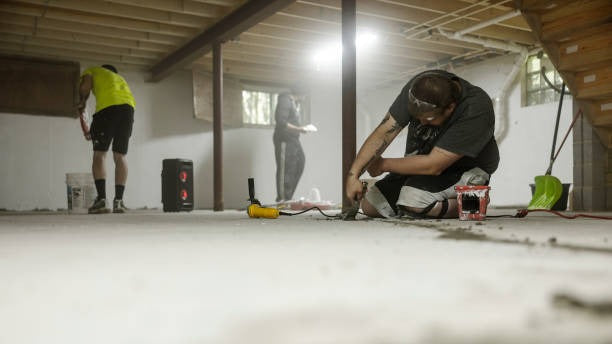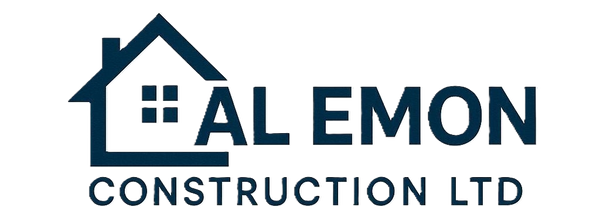
Basement Waterproofing
Did Your Neighbors Just Waterproof Their Basements? Here's How You Can Too

Think of basement waterproofing as a raincoat for your home. It keeps the water out while keeping the inside dry and healthy. Professional tanking solutions use special materials on your basement walls and floors to create a waterproof seal that stops moisture from coming in.
The benefits of proper waterproofing go beyond just immediate protection:
- Property Value Protection: A dry basement helps maintain your home's market value
- Health Risk Prevention: Stops mold and mildew growth
- Cost Savings: Lowers long-term maintenance costs
- Space Utilization: Allows you to use your basement as livable space
A well-done waterproofing system is your first defense against water damage. This investment protects your property from expensive repairs and ensures a healthy living environment for you and your family.
Common Causes of Basement Moisture
Understanding the root causes of basement moisture helps you identify and address potential issues before they escalate into serious problems. Here are the primary factors that contribute to basement water problems:
1. Hydrostatic Pressure
The soil surrounding your basement walls becomes saturated with water during heavy rains or snow melts. This creates intense pressure that forces water through any available opening in your foundation.
2. Foundation Issues
Foundation problems can lead to water intrusion in your basement. Some common foundation issues include:
- Cracks in foundation walls
- Deteriorating mortar joints
- Gaps around utility penetrations
- Settlement-related structural damage
3. Drainage System Problems
Ineffective drainage systems can cause water to pool around your home's foundation, increasing the risk of basement moisture. Look out for these drainage system problems:
- Clogged or damaged gutters
- Disconnected downspouts
- Inadequate slope of drainage pipes
- Missing or broken drain tiles
4. Landscape-Related Issues
The way your yard is graded, and the type of soil present can impact how water flows away from your home. Consider these landscape-related factors:
- Improper yard grading directing water toward the house
- Soil settled near foundation walls
- Poor soil composition affecting water absorption
- Insufficient drainage away from the structure
5. Window and Vent Vulnerabilities
Windows and vents can be potential entry points for moisture if not properly maintained. Check for these vulnerabilities:
- Damaged window wells
- Improperly sealed window frames
- Blocked window well drains
- Deteriorated vent seals
6. Indoor Sources
Moisture can also originate from within your home. Be aware of these indoor sources:
- Leaking water supply lines
- Faulty appliance connections
- Damaged waste pipes
- Condensation from HVAC systems
These issues can work independently or combine to create significant moisture problems in your basement. Each source requires specific remediation strategies to ensure effective waterproofing.
Recognizing Signs of Water Issues in Your Basement
Water problems in your basement can manifest through various warning signs. Learning to identify these indicators early helps prevent extensive damage to your property.
Key Warning Signs:
- A persistent musty smell that lingers despite opening windows or running dehumidifiers
- Dark or damp spots on walls or floors
- Peeling, bubbling, or flaking paint
- Rust stains on walls, floors, or furniture
- White, chalky substance (efflorescence) on concrete or brick surfaces
- Visible mold growth in corners or on walls
- Warped or rotting wooden structures
- Condensation on windows or pipes
- Visible cracks in foundation walls or floor
- Salt deposits appearing on walls
Physical Changes to Watch:
- Doors or windows becoming difficult to open or close
- Bowing or buckling of basement walls
- Uneven or sloping floors
- Gaps between walls and floors or ceilings
- Deteriorating carpet or lifting floor tiles
These signs often appear gradually. Regular basement inspections help catch potential water issues before they develop into serious problems requiring extensive repairs. A thorough check of your basement every season, particularly after heavy rainfall, allows you to spot these warning signs early.
Key Factors to Consider for Successful Basement Waterproofing
The success of your basement waterproofing project depends heavily on understanding your property's unique characteristics. Here's what you need to consider:
1. Soil Analysis
Different types of soil behave differently when it comes to water retention and drainage. Here's how each type of soil can impact your waterproofing efforts:
- Clay-rich soil retains moisture and expands, requiring robust drainage solutions
- Sandy soil allows better natural drainage but might need stabilization
- Loamy soil provides balanced drainage properties
Testing your soil composition through professional analysis or DIY methods can help you determine the appropriate waterproofing methods for your property.
2. Drainage Patterns
Understanding the existing drainage patterns around your property is crucial in effectively managing water flow. Consider the following factors:
- Natural slope direction around your property
- Water table depth in your area
- Existing drainage systems' effectiveness
- Potential impact on neighboring properties
By identifying any potential issues with water accumulation or diversion, you can implement targeted solutions such as French drains or swales to redirect water away from your basement.
3. Climate Considerations
The climate in which you live has a significant influence on the type of waterproofing measures required for your home. Consider these climatic factors:
- Annual rainfall in your region
- Seasonal precipitation patterns
- Freeze-thaw cycles that can affect foundation
- Temperature variations impact on materials
For example, if you reside in an area with heavy rainfall, investing in an efficient sump pump system may be necessary to prevent flooding during storms.
4. Property-Specific Elements
Every property has its own unique features that can affect its susceptibility to water intrusion. Consider the following elements specific to your property:
- Age of your foundation
- Previous waterproofing treatments
- Location of utility lines
- Proximity to water bodies (such as rivers or lakes)
- Landscaping features affecting water flow (such as slopes or retaining walls)
These factors will help you assess any vulnerabilities in your home's structure and tailor your waterproofing approach accordingly.
Understanding these key factors allows you to select appropriate waterproofing solutions that address the specific needs of your property. For instance, properties in areas with extreme temperature fluctuations may require flexible waterproofing materials that can accommodate movement caused by freezing and thawing cycles.
Additionally, it's important to be aware of local building codes and regulations that govern basement waterproofing practices in your area. These guidelines often reflect regional environmental challenges and proven solutions for effectively managing water intrusion issues.
By considering these key factors and complying with relevant regulations, you'll be better equipped to implement a successful basement waterproofing strategy that protects your home from moisture damage.
The Importance of Professional Evaluation and Ongoing Maintenance for Long-Term Results
Professional basement waterproofing requires specialized knowledge and expertise. A qualified expert can:
- Conduct thorough moisture testing
- Identify hidden water entry points
- Assess structural integrity
- Ensure compliance with local building codes
- Provide detailed documentation for insurance purposes
Your basement's waterproofing system needs regular maintenance checks to maintain its effectiveness. Here's a practical maintenance checklist:
Monthly Tasks:
- Clear gutters and downspouts
- Check sump pump operation
- Inspect window wells for debris
- Monitor humidity levels
Seasonal Tasks:
- Clean exterior drainage systems
- Test backup sump pump batteries
- Examine foundation walls for new cracks
- Verify proper grading around foundation
Annual Professional Inspection:
- Complete system assessment
- Performance testing of all components
- Calibration of monitoring devices
- Documentation of system condition
At Al Emon Construction Ltd, our certified technicians use advanced diagnostic tools to detect potential issues before they become major problems. We provide detailed reports and recommendations based on your specific basement conditions and local environmental factors.
A professional evaluation helps prevent costly mistakes and ensures your waterproofing solution meets industry standards. Regular maintenance extends the life of your waterproofing system and protects your investment in your home's foundation.
In addition to these practices, it's essential to stay informed about flood risks and safety measures that can further protect your home from water damage.
Conclusion
Basement waterproofing is an important investment in your home's longevity and your family's well-being. The methods discussed here from interior waterproofing techniques to advanced technological solutions - give you a variety of options to effectively deal with moisture problems.
Don't wait for water damage to happen. Take action now:
- Schedule a professional assessment of your basement's current condition
- Implement appropriate waterproofing solutions based on expert recommendations
- Set up regular maintenance checks to ensure long-lasting protection
Your neighbors have already taken steps to protect their homes - it's time for you to do the same. Contact Al Emon Construction Ltd today for a comprehensive evaluation of your basement waterproofing needs. Our team of specialists will help you choose and implement the most effective solutions for your specific situation.
FAQs (Frequently Asked Questions)
1. What is basement waterproofing and why is it important?
Basement waterproofing involves applying methods and materials to prevent water infiltration into basement spaces. It is crucial for protecting properties from costly water damage repairs and maintaining a healthy living environment by preventing mold, mildew, and structural deterioration.
2. What are the common causes of moisture problems in basements?
Common causes include hydrostatic pressure, poor drainage systems, foundation cracks, improper grading around the house, rainwater infiltration through windows or vents, and indoor leaks from plumbing fixtures or appliances. Recognizing these causes helps in selecting effective waterproofing solutions.
3. What are the signs that indicate water problems in my basement?
Signs include persistent dampness or musty odors despite ventilation, peeling paint or wallpaper, efflorescence (white powdery substance) on walls, and visible concrete cracking. Early detection of these symptoms is essential for timely waterproofing intervention.
4. What are the effective methods available for waterproofing a basement?
Effective methods include interior waterproofing techniques such as sealants and coatings applied to walls and floors and installing sump pumps; exterior waterproofing solutions like excavation to install waterproof membranes and French drains; comprehensive multi-step approaches combining both interior and exterior methods; and integral waterproofing using water-resistant concrete during construction.
5. How do advanced technologies enhance basement waterproofing?
Advanced technologies such as liquid-applied membranes, high-performance sealants, and smart sump pumps with monitoring capabilities provide enhanced protection by improving moisture barriers, offering durable sealing solutions, and enabling proactive water management through real-time monitoring.
6. Why is professional evaluation and ongoing maintenance critical for basement waterproofing success?
Professional evaluation ensures tailored waterproofing solutions that comply with building codes and effectively address specific site conditions like soil permeability and local climate. Ongoing maintenance tasks such as clearing debris from drains and checking sump pump functionality are vital to sustain system performance and prevent future water damage.
